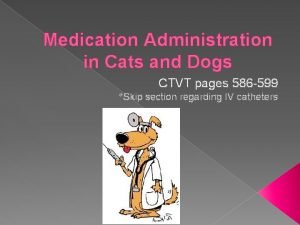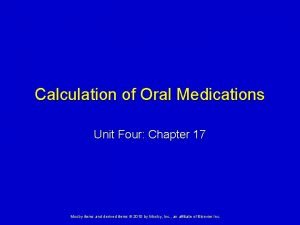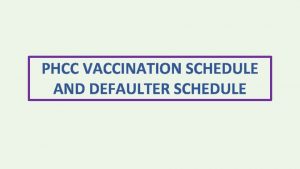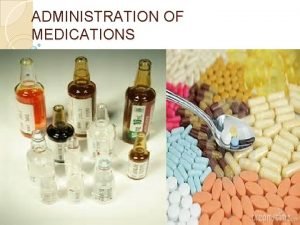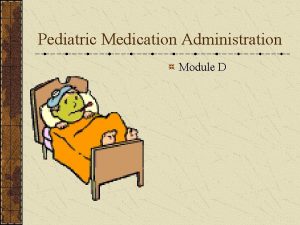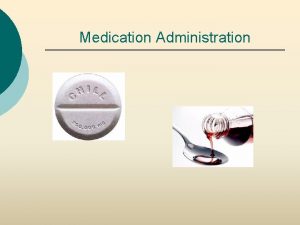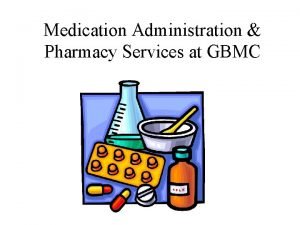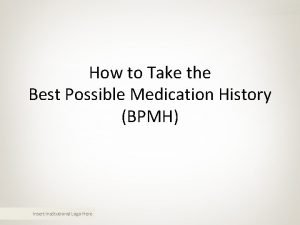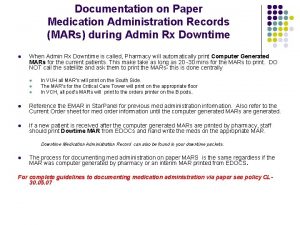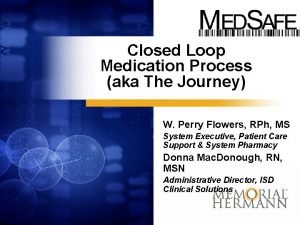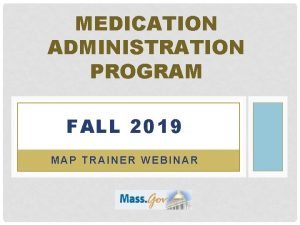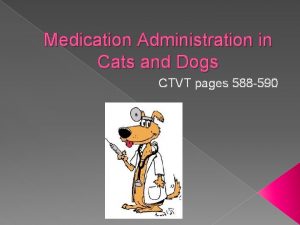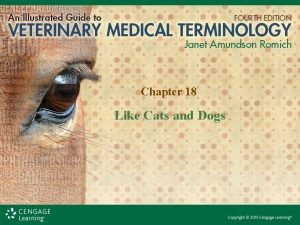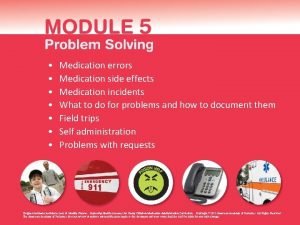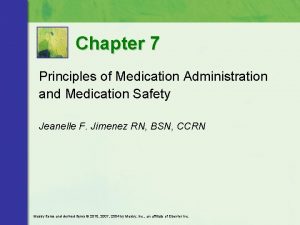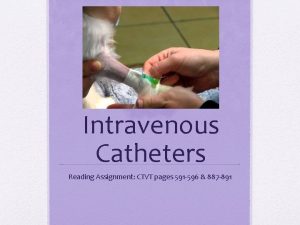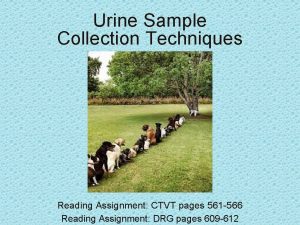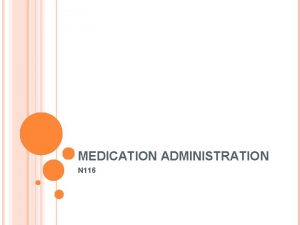Medication Administration in Cats and Dogs CTVT pages































- Slides: 31

Medication Administration in Cats and Dogs CTVT pages 586 -599 *Skip section regarding IV catheters

Objectives � Understand how to safely and accurately administer medications to cats and dogs � Understand the equipment needed to administer medications � Understand potential complications from medication administration � To perform an intramuscular injection � To perform an intravenous injection

Routes of Medication Administration � � Oral (PO) Via feeding tube › Esophagostomy › Gastrostomy › Jejunostomy � � � Orogastric intubation Nasogastric intubation Rectal (PR) � � � � › Nebulized or volatilized � � Aural Topical ophthalmic Transdermal Transmucosal Sublingual Intranasal Inhalation Intratracheal

Parenteral Routes: Needle Required o Intradermal (ID) o Subcutaneous (SC or SQ) o Intramuscular (IM) o Intravenous (IV) o Intraosseous (IO) o Intraperitoneal (IP) o Epidural/subdural o Intracardiac (IC)

How Do We Decide Which Route is Best? Patient Factors � Health conditions Drug Factors � Formulation of drug › Symptoms � Absorption rate of drug required � Systemic vs. local effect desired � Temperament � Ease of administration for client � Cost

Other Factors to Consider � Does the medication require any special precautions to be followed during administration? › Examples: � Potential side effects of drug? › Examples: �Pain at injection site �Vomiting/GI upset/constipation � Can it be combined with other prescribed meds?

Supplies Needed 1. 2. 3.

Accurate Dosing Based on Syringe Size

Needles � Needle gauge is determined by: › Route of administration › Amount of drug › Consistency of drug � Two needles are required: › One to draw up the medication › One to administer the medication Why is this? _______________

Process for Changing Needle � Draw up exact amount of drug › Use the same gauge needle as administration � Aspirate all drug into the syringe (out of needle) › This prevents _________ � Remove needle and replace with new needle � Carefully ensure all air is out of the syringe by slowly depressing the plunger › Medication should fill the hub � Ensure accurate amount of medication

Injectable Drugs � Supplied as: 1. Sterilized solutions 2. Sterilized suspensions 3. Powders that must be mixed, or ________ with sterile solution � May be stored in: › Vials (single or multi-dose) › Ampules


Angle of Syringe is Important

Intradermal Injections � Indications for: 1. Local nerve block 2. Allergy skin testing � Skin is usually shaved before this injection � Animals � Drug are usually sedated does not go _______

Intradermal Administration

ID Injection Procedure � Skin is pulled taught and a _____ gauge needle is attached to a syringe and inserted with the bevel up into the _____. › If allergy testing: A ____ volume of allergen is injected. › If locally anesthetizing skin: dose of drug based on weight �Two most common local anesthetics: � The injection site will look like a translucent lump if the injection is performed correctly › Referred to as a _____


Intramuscular Injections � Indications for IM injections: › Anesthetics/sedatives �Convenient route of administration for ______ animals › Pain medications › Heartworm treatment � Appropriate route for injection of _______ volumes of medication � Generally, more painful for animals than SC or IV. › Why?

IM Injection Sites Lumbosacral region 1. Epaxial muscles: ______ to the dorsal spinous processes Hind limb 1. 2. Quadriceps muscle

Epaxial Injections � Inject deep into the third to fifth lumbar region of the epaxial muscles › 2 -3 fingers lateral to the spine � Used to administer _______ heartworm treatment Drug name: _________ Brand Name: Immiticide®

Hind Limb Injections � Quadriceps: most cranial aspect of limb � Semimembranosus/ semitendinosus: small straps of muscle belly on the caudal aspect of limb *Needle should always be directed away from the ____________.

IM Injection Procedure Isolate the muscle between the fingers and thumb of nondominant hand. � Hold the syringe so you do not have to take your hand off of it to aspirate. � A ______ gauge needle attached to a syringe is embedded into the muscle at a ______ angle. � Once in the muscle completely, aspirate. � › What should you feel? _____________________ › What do you do if you see blood in needle hub? Inject the medication. � Massage the site for a few seconds after the injection to help distribute the liquid. � › Exception:

While You’re Injecting… � How do you know how deep to go? � Watch needle closely! › If we move in or out, OR if the animal moves, we should _______. � If the animal moves drastically, we must remove our needle!

Possible Complications from IM Injection � Tissue trauma � Nerve damage *This is a painful injection route- be ready for the animal to react/move upon injection (have good restraint) **Sometimes they do not react to the needle, but to the liquid being injected!

Intravenous Administration � Drugs a vein and/or fluids may be injected directly into � IV route produces an immediate, ______ response to the drug � Supplies needed: › Syringe › 2 needles of the same gauge › Alcohol cotton › Drug

Indications for IV Administration › › › Inducing anesthesia Chemotherapeutic agents Anti-convulsant drugs Vesicants Antibiotic therapy Emergency/resuscitation drugs

IV Injection Sites � Cephalic is most common › Saphenous may be used if needed � Jugular is not used unless a ________ catheter is placed

IV Injection Instructions � � Pull up the drug (same as for IM injection) Expel all air bubbles from the syringe prior inserting into the vein. to › Prevents ___________ � Restrainer should occlude the vessel � Swab the skin with an alcohol cotton ball � Insert a 20 - to 25 - gauge needle, bevel up into the vein. › Only go in until a flash is seen › Confirm placement by gentle aspiration

IV Injection Instructions � Venipuncturist: communicate to restrainer “I’m in” or “ready to inject” � Restrainer: release pressure from the vein › Why is this important? � Inject the medication into the vein � Once complete, communicate with restrainer and remove the needle � Apply firm digital pressure to the injection site until hemostasis/coagulation occurs

IV Injection Tips � If injecting a large volume of drug or have movement of needle: Re-aspirate to confirm placement in vein �Restrainer must _______ again! � If multiple drugs are prescribed or repeated access is needed, an intravenous catheter should be placed

Possible Complications with IV Injections � Air-embolus � Septicemia � Hematoma/Perivascular injection of drug › Incorrect absorption rate › Skin sloughing if a _______ is given DRG page 497
 The flowers dance as the wind blows figure of speech
The flowers dance as the wind blows figure of speech Journal of a lumpy kid by ken jiffy
Journal of a lumpy kid by ken jiffy Epaxial injection dog
Epaxial injection dog What is hyperbole in figure of speech
What is hyperbole in figure of speech Printed pages vs web pages
Printed pages vs web pages Medication administration 1 pretest
Medication administration 1 pretest Injectable medication administration ati posttest
Injectable medication administration ati posttest Chapter 17 dosage calculation and medication administration
Chapter 17 dosage calculation and medication administration Defaulter vaccination schedule
Defaulter vaccination schedule Volutrol
Volutrol Concepts of medication administration pretest
Concepts of medication administration pretest Six rights of medication administration
Six rights of medication administration Six rights of medication administration
Six rights of medication administration 8 rights of medication administration
8 rights of medication administration Fried's rule formula
Fried's rule formula Iv medicine ball
Iv medicine ball 7 rights of medication administration in order
7 rights of medication administration in order Therapeutic class and pharmacologic class
Therapeutic class and pharmacologic class Closed loop medication administration safety initiative
Closed loop medication administration safety initiative Chapter 31 medication administration
Chapter 31 medication administration Dosage abbreviations chart
Dosage abbreviations chart Instillation route of medication administration
Instillation route of medication administration Best possible medication history form
Best possible medication history form Paper medication administration record
Paper medication administration record Closed loop medication administration
Closed loop medication administration Macy catheter medication administration
Macy catheter medication administration Himms emram
Himms emram Tmu map test
Tmu map test Cats of borneo chronological order
Cats of borneo chronological order The day they parachuted cats into borneo food web
The day they parachuted cats into borneo food web Learner response systems
Learner response systems Learning reactivity series
Learning reactivity series


